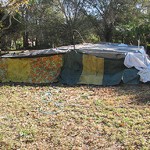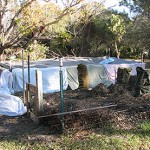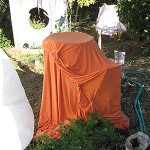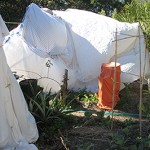In The Garden: When It Is Cold, Sheets & Straw To The Rescue
- The Neighbor's Garden
- Neighbor's Tarps Over 2x4 Frame
- Tomato and Pepper Plants Covered
- Tented Pigeon Pea Plant
- Staghorn Fern Gets A Bedspread
It is barely winter and here in South Florida we are having another very cold season. In the garden this matters terribly when winter is your primary growing season, and just a few degrees can make or break your harvest. We who grow here are ready for this. We have stacks of sheets, and tarps, boxes of clothes pins and clamps, and STRAW! Blessed straw comes to the rescue yet again. Anyone who has had to protect a tomato plant in its prime from frost or freezing temperatures knows just throwing together a quick frame and throwing up some sheets can be a coin toss for that beloved plant.
Even with expecting cold weather, choosing our warmest spots for our most tender vegetables, and growing lots of brassicas, onions, and carrots every where else, we need lots of great strategy for protecting our tender and often favorite vegetables. Local farmers are losing millions of dollars in tomatoes in these low temperatures. There isn’t much they can do for a field of tomato plants in 20 degree weather, but we gardeners having far fewer plants to protect, can afford to put lots of effort into just a few plants.
It is very important that plants are not stressed by dry conditions going into a freeze. Be sure to do your watering well ahead of plunging evening temperatures. Properly moist soil helps to hold the days warmth. Build frames for your large plants before the cold weather comes so that your most critical time is spent simply covering the frames. Be sure that your frames are higher than the highest leaves of your plants. If the plants are touching the covers they will be damaged on those surfaces. An air layer between the covering and the plant will provide the best protection. Cover all the way to the ground, folding joints before clipping to avoid cracks where cold air can get in.
I have had very good luck protecting tomato plants in spacious tents with a few feet of air space above the plants in which to hang an incandescent metal dome light. This is also potentially dangerous. At the very least, plant’s leaves too close to the lamp will be burnt, and it is not difficult to imagine how a rickety tent on a windy night might collapse, and the sheets fallen on the lamp would burn. Be cautious and safe if you are adding electric heat to your tented vegetables.
I have recently discovered that straw makes an ideal covering for smaller tender plants. If the eggplant, tomato, bean, potato or pepper isn’t more than hip high straw will work. To cover with straw start at the ground with loose straw, and pile up beneath and around the sides of the plant tucking in around branches as you pile up. At the top shake straw over the last exposed leaves until they are well covered. The straw keeps leaves from frost exposure and it holds air inside keeping the temperature slightly higher than the air outside. I have also re-covered a straw covered tomato plant in a taller tomato cage with sheets to create a warm space above the top of the straw. For a tented plant, at ground level where your cloth or tarp tent meets the earth, a seal all the way around inside or out with straw will help seal the tent sides to the ground and trap the warmth inside.
Windy days are a particularly trying challenge for covering, and it is often the case that wind brings the cold front from which we are protecting our plants. You may need to recheck your covering, and re-stack some straw once the wind dies down. If the wind persists, or you have just one chance to cover and go, crisscrossed bamboo sticks will hold straw down. It is a good idea to know where your plants are in the straw before shoving sticks through.
I find covering plants against cold weather is exhausting work, and worrying about protecting plants through unseasonably cold conditions can take me to the edge of despair, as even the best prepared covers are no substitute for the proper warm days and cool nights we have come to expect for our growing season. These events stress our plants, and they can stress us pretty well too. It is good if we can maintain our sense of humor through this. Mother Nature does as she will. Plant heavily in brassicas (cabbage, kale, collards, radishes, arugula, mustards and broccoli), and onions, carrots, lettuce, and peas as they are able to take some very cold temperatures, and be ready with new tomato plants, and more beans to put out as soon as it is warm again. There is always the next crop.
Once I became serious about growing food I quit worrying about protecting my ornamental plants in cold weather, and I have found that most of the ornamentals I have on my property even if they are damaged in cold weather will come back vigorously in the spring. I do carry in just a few orchids that I keep near my entranceway, but the orchids I keep down in the woods stay where they are. If it will be well below freezing they get dropped to the ground and covered with palm fronds, but they seem to do fine there no matter what, and this speaks to understanding the micro-climates on your property. I have found that my woods, lower than the fill on which my house sits, with multiple levels of canopy, un-raked and always moist is the warmest in the winter, and the coolest in summertime. This is also true of the area where my pond is situated, and in that case I believe it is the pond that creates the climate in its vicinity. These intense weather swings offer us an opportunity to learn about our land, and may help us in the future with our planting plans.
Y’all keep warm, and eat what you can’t save.






6 Responses
Love your motto, “eat what you can’t save…” We feel that way every time we open the fridge. Good points about the cold. We are used to the cold weather but worry about all those beautiful oranges when the weather gets c old down south.
She said it all. Learn from the master. It is a lot of work operating a vege garden. The payoff is at the dinner table. Then it is all worth it when you taste a tomato for the first time.
Thanks for your comment Dorothy.. too funny about your refrigerator, but also true. I think the citrus growers have a very hard time with the cold too, but not as bad as the tomato farmers, and if they get the fruit through the cold it is the sweetest fruit. The cold does that.
Thanks for your comment Danny, and amen to that!
You are right that it is a bit of work to cover the garden but I get a lot of satisfaction from seeing my tomato plants thriving when I uncover them the next day (especially when the night time temps are in the 20s). I have been using old bedspreads and sheets for covers and clip them together with metal clamps —this helps them not blow off at night. It might make more sense for me to stitch the coverings together (using a sewing machine) and make one big cover that would be easier to put on and just clamp them down at the base of the garden.
I also stopped covering my other flowering plants when I started covering my veggie garden — and they mostly do fine in the long run. I think a few plants I used to cover can take the cold anyway.
Thanks for all the good info!
Thanks for your comment Lisa, I am very glad to hear how your tomato plant survived the cold. I think it is an excellent idea to use your sewing talents to create one big cover for your garden. Along with a good frame work it will make your covering chores a snap.